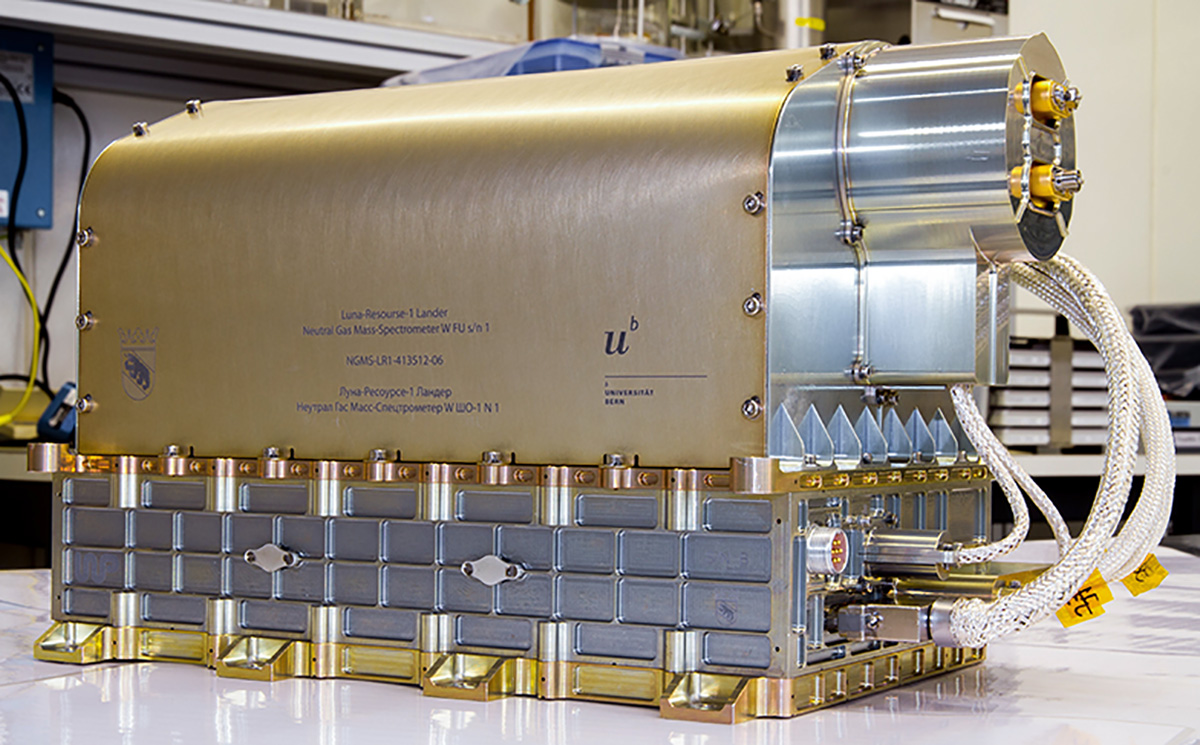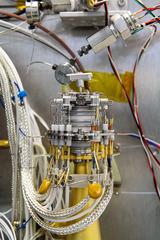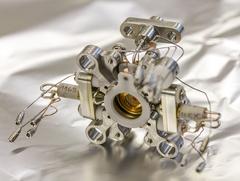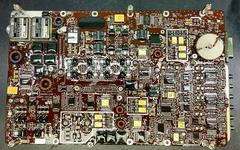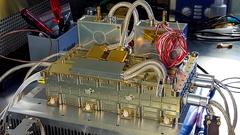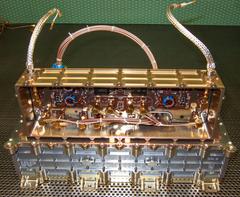Instrument
NGMS – Time of Flight Neutral Gas Mass Spectrometer (TOF –MS)
The NGMS is a compact Time-Of-Flight Mass Spectrometer (TOF-MS) with a grid-less ion mirror (a reflectron). The sensor itself is a vacuum tight system except for two entrances, which are the exhaust tube and the gas inlet originating from the gas chromatograph. The whole instrument is designed as low power neutral gas mass spectrometer, which can be fully operated with 25W in a rough space environment between -30°C up to 80°C.
The NGMS instrument benefits from heritage from the Reflectron Time-Of-Flight mass spectrometer (RTOF), which was part of the Rosetta mission of ESA that contributed to the understanding of the comet 67P/Churyumov-Gerasimenko. Despite the RTOF flight heritage, the design for Luna-Resurs required a drastic miniaturization to comply with the requirements. As the spacecraft provides a limited budget concerning power, size, and mass, we designed the instrument in a way to maximize the return on science while making them as energy efficient and small as possible. The resulting highly customized instruments are the most energy efficient of its class while possessing an excellent sensitivity.
The NGMS TOF-MS for space research has a fairly simple and robust mechanical design and has a moderate need for resources. Moreover, because the instrument records all masses at the same time it has high sensitivity. Size, mass, and power consumption of the NGMS instrument are unique in space-born mass spectrometers, and allow for outstanding performance of the instrument.
With these capabilities, the upcoming analysis of the lunar regolith and the lunar exosphere could significantly improve our understanding of the source of lunar volatiles and present mechanisms of their release from the crust.
Mass, size and number of parts
The mass of the NGMS instrument is about 3.5 kg and the maximum size is 26x15x18 cm3. Its electronics consists of around 2337 total parts from which roughly 10% are unique parts. This is in the same range as a copy machine (Ulrich, Eppinger and Yang, 2020).
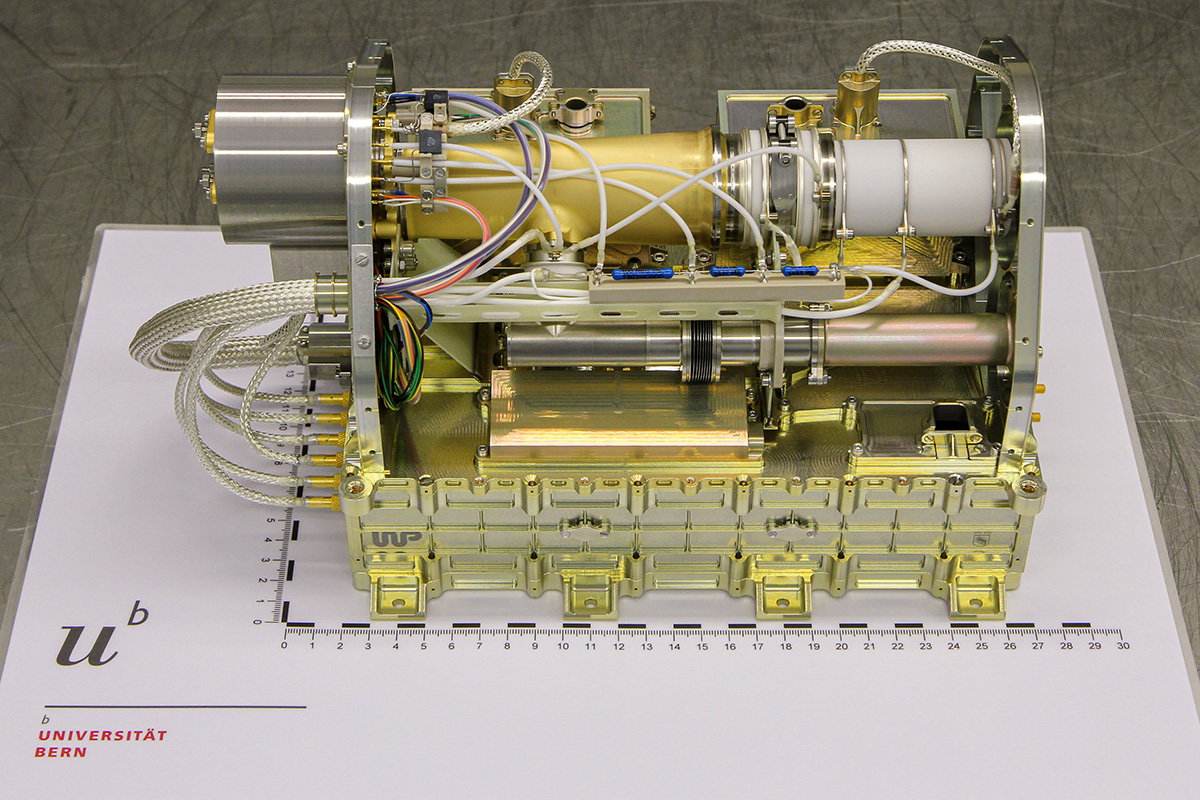
NGMS – as part of the Gas Analytical Package instrument suite (GAP)
The Neutral Gas Mass Spectrometer (NGMS) instrument is part of the Gas Analytical Package instrument suite (GAP). GAP further includes a pyrolysis oven for the release of volatiles from regolith samples and a miniaturized gas chromatograph (GC) for chemical pre-separation of the extracted volatiles developed by the French and Russian collaborators. The NGMS instrument will be coupled to the gas chromatograph for the detailed chemical analysis of the separated gas from the samples.
NGMS IOS and electronics pictures
How the mass spectrum is obtained
In a time-of-flight mass spectrometer, all masses are recorded at the same time. Different velocities result from differences in mass of the molecular ions, thus separatng the ion mixture into a sequence according to their mass.
1. The Ion Source with its filament
The neutral gases enter the ion source directly from the output capilary of the Gas Chromatograph (GC) . The ion source consists of several electrodes for electron beam guiding, ion storage, and ion extraction. The filament (the cathodes) provides electrons that are needed for ionizing the neutral gas species in the ion source. For the NGMS instrument, this filament is a thermionic emitter. In terms of electronics, the filament represents a resistive wire that is heated until its electron emission temperature is reached.
2. The High Voltate Pulsers
The mass separation is performed by accelerating all ions to the same energy: Triggered with a rise time of nanoseconds by an ultrafast High Voltage Pulser by the primary pulser, the applied electrical field from the extraction gate accelerates the ions from the source towards the drift tube. All ions gain the same initial kinetic energy by the primary pulser. The secondary High Voltage Pulser prevents the ions from the carrier gas to reach the detector.
3. The Drift Region with its Ion Mirror
After flying through the field-free drift region (the drift tube), the ions enter the ion mirror. The ion mirror fulfills two tasks: First, it doubles the flight path of the ions in the drift region without increasing the instrument dimensions. An increase in drift length increases the flight time, which results directly in an increase of mass resolution. Second, the ion mirror provides the capability of correcting the time spread resulting from the initial thermal energy distribution in the ion source. Ions with a higher energy will penetrate deeper into the repelling field of the ion mirror than ions with a lower energy will do, meaning that faster ions have a longer time-of-flight through the ion mirror.
4. The Ion Detector
The ion detector is used to measure ions, which completed their time-of-flight path through the instrument. Hence, the determination of the mass-to-charge ratio takes place by measuring transit time of the particle (the time of flight). The detector will provide a pulse shaped electrical signal, which is proportional to the number of incident ions that is converted into a mass spectrum. For the analysis of an unknown gas, the time scale has to be converted to a mass scale by the so called mass calibration.
Operations Modes
The instrument performance allows for very sensitive measurements of the lunar exosphere, either from ground or from low-lunar orbit. Hence, the NGMS has two major scientific operations modes:
Exosphere mode
In exosphere mode, the NGMS instrument measures directly gases of the lunar exosphere to which it has access via the exhaust tube from the location of the lander on the lunar surface or while inserted into artificial lunar satellite orbit.
Gas chromatograph mode
In gas chromatograph mode, the instrument samples the output of the gas chromatograph. The drill unit on the lander provides soil samples of the upper lunar soil down to 1 meter depth to the pyrolysis oven where the samples are heated up to 1000°C. The released volatiles are then either separated by the GC and further analyzed by the NGMS, or directly analyzed by the NGMS.
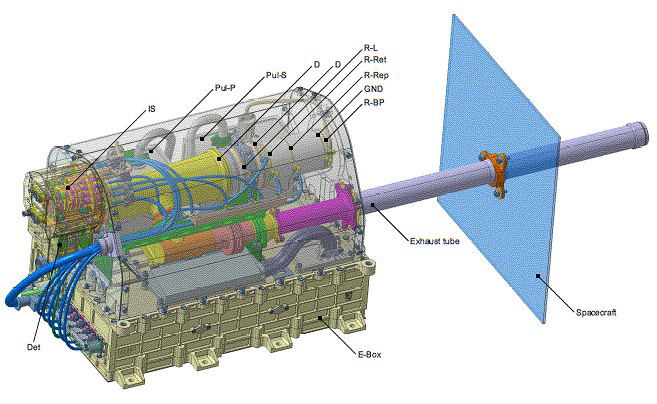
Future outlook for the NGMS instrument
The NGMS design is applied to two other instruments:
- First, the mechanical design of the NGMS instrument was also the base for the development of the NIM spectrometer, which will be flown on the JUICE Mission
- Second, the instrument was commercialized. A spin-off company of our institute (Spacetek) was established around the technology of this instrument. The final design of the NGMS instrument was commercialized and adapted for the use in the Internet of Things (IoT).
